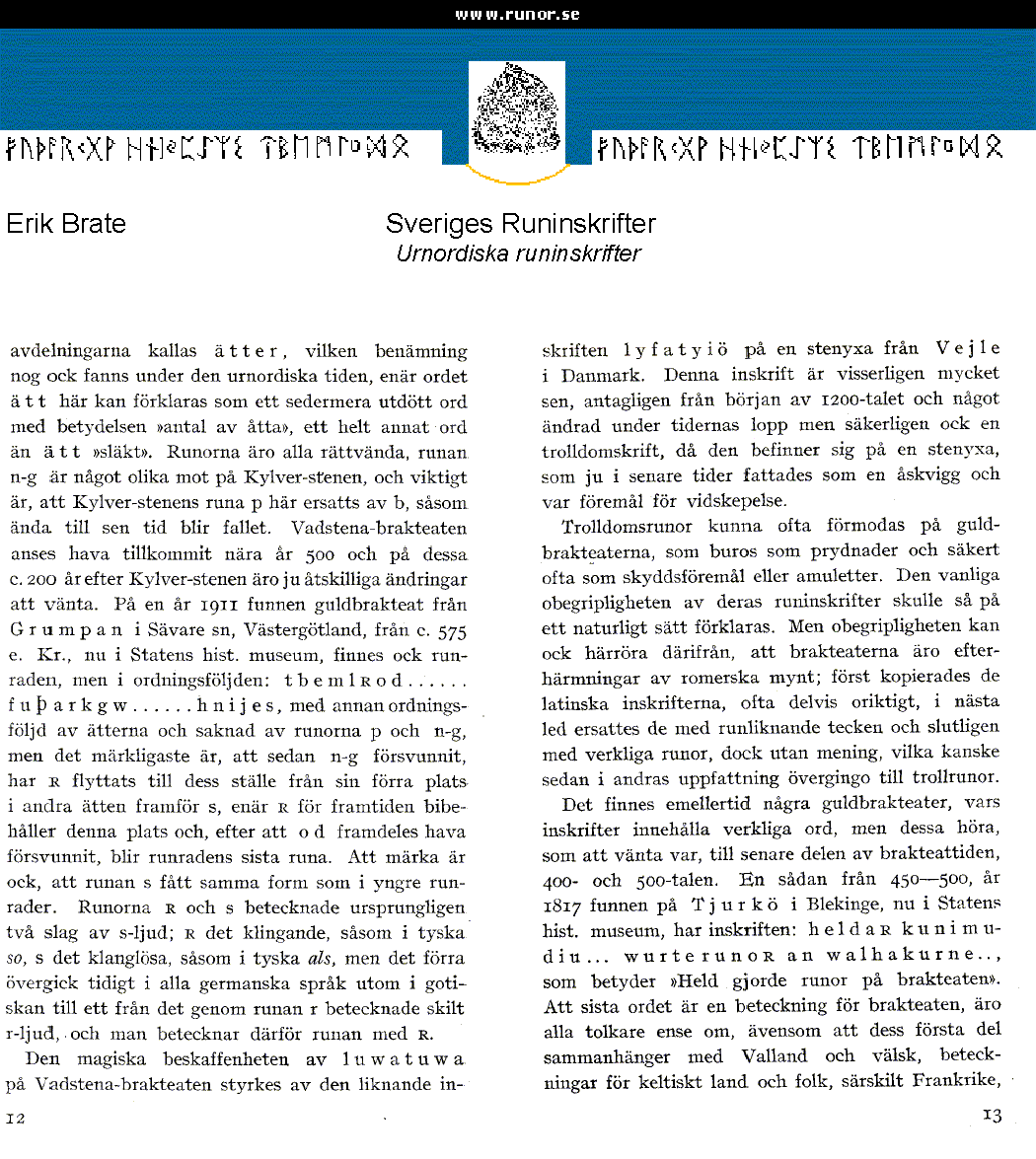
the sections is called families, which
name also existed during the old nordic
time, since the word family here can be explained as an afterward
extinct words with the importance numbers of eight, an entire other
word than family related. The runes are all turned the right way, the
rune ŋ is some different against the one on the Kylver-stone,
and important is, that the Kylver-stones
rune p here been replaced of b, which was preserved for a long time.
The Vadstena - bracteate
is considered to been made around 500 AD and on these c. 200 years
after the Kylver - stone multiple changes
is to be expected. In the year 1911 there was a find of a gold bracteat from Grumpan
in Sävare, Västergötland, from c. 575 AD, now in the State's hist. museum, is also the runic sequence, but in
the sequence:
t b e m l R o d
......f u þ a r k g w ...... h n i j ї s, with other sequence of the families and regret of the
runes p and ŋ, but the most odd is, that since ŋ to disappeared, has R
been moved to its place from your previous place in other family before
s, since R for the future maintains this place and, after that o d
later on have disappeared, becomes the runic sentence last rune.
Observe that the rune s got the same shape that in the younger runic
sentence. The runes R and s denoted originally two kinds of s-sounds; R
the sounding, as in German so, s the toneless, as in German alder's,
but the previous passed on early in all germanic
languages, except in gotic, to a from the
through the rune r denoted separated r-sound, and one denotes therefore
the rune with R.
The magic
characteristic of luwatuwa
on the Vadstena - bracteate
is confirmed of the similar inscript lyfatyiö
on a stone axe from Vejle in Denmark. This
inscription is probably late, from the start of the 13th
century and some changed during the times' travels but doubtless also a
magic script, then the is located on a stone axe, that in latter times
was taken as a thunderbolt and each object for superstition. Magic
runes are often assumed on the gold bracteates, which was worn as
decorations and often as protection objects or amulets. The common
incomprehensibility of their runic inscriptions will then on a natural
way be explained.
But the incomprehensibility can also derive from the fact, that the bracteates is imitations of Roman coins; first was copied the Latin inscriptions, often partially incorrect, in next stage was replaced with the runic alike signs and finally with the true runes, however without sense, which in another viewers went over to magic runes. The is found however some gold crash theatre, whose inscriptions contain true words, but these to consult, that to wait each, to the latter part of the time of the bracteates, 400 - to 500 AD. Such a from 450-500, in the year 1817 found on Tjurkö in Blekinge, now in the State's hist. museum, has the inscription:
heldaR kunimudiu...wurte runoR an
walhakurne..
that means Held did the runes on the bracteate. That the last word is a term for bracteate, renown all interpreters agreed about, even that its first part is connected with Valland and välsk, terms for Celtic country and ethnic, special France,
But the incomprehensibility can also derive from the fact, that the bracteates is imitations of Roman coins; first was copied the Latin inscriptions, often partially incorrect, in next stage was replaced with the runic alike signs and finally with the true runes, however without sense, which in another viewers went over to magic runes. The is found however some gold crash theatre, whose inscriptions contain true words, but these to consult, that to wait each, to the latter part of the time of the bracteates, 400 - to 500 AD. Such a from 450-500, in the year 1817 found on Tjurkö in Blekinge, now in the State's hist. museum, has the inscription:
heldaR kunimudiu...wurte runoR an
walhakurne..
that means Held did the runes on the bracteate. That the last word is a term for bracteate, renown all interpreters agreed about, even that its first part is connected with Valland and välsk, terms for Celtic country and ethnic, special France,